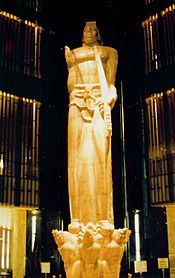Vision of Peace (Indian God of Peace) facts for kids
The Vision of Peace is a large and important statue. It stands in the main lobby of the Saint Paul City Hall and Ramsey County Courthouse in Saint Paul, Minnesota, United States. This amazing artwork was created by a Swedish artist named Carl Milles. It serves as a special memorial to people from Minnesota who died in wars during the 1900s.
Milles got his idea for the statue after seeing a Native American ceremony. He saw this ceremony in Ponca City, Oklahoma. He called his artwork Indian God of Peace at first. The statue shows five Native Americans sitting around a fire. They are holding their sacred pipes. From the smoke of these pipes, a "god of peace" appears. Milles imagined this figure speaking to "all the world."
What is the Vision of Peace Statue?
The Vision of Peace statue was first shown to the public on May 28, 1936. It was originally named Indian God of Peace. At that time, it honored 340 people who died in World War I. Later, in 1988, a group called the VFW started raising money. They wanted to add names of Minnesota soldiers who died in other wars. These included World War II, the Korean War, and the Vietnam War.
Today, the statue has 1,578 names engraved on it. These are the names of people lost to war. In 1994, the statue was given its new name, Vision of Peace. This happened at a special event with three major Native American tribes from Minnesota.
How Big and Heavy is the Statue?
This impressive statue is very large and heavy. It weighs about 60 tons, which is like 10 elephants! The statue stands 38 feet tall. That's as tall as a four-story building. It was carved from a creamy white stone called Mexican onyx. Milles used a full-size model to create it.
The statue sits on a special base that slowly turns. It rotates 132 degrees every 2.5 hours. The statue is made of 98 different sections. These sections are attached to a strong steel beam. They are also supported by bronze ribs.


